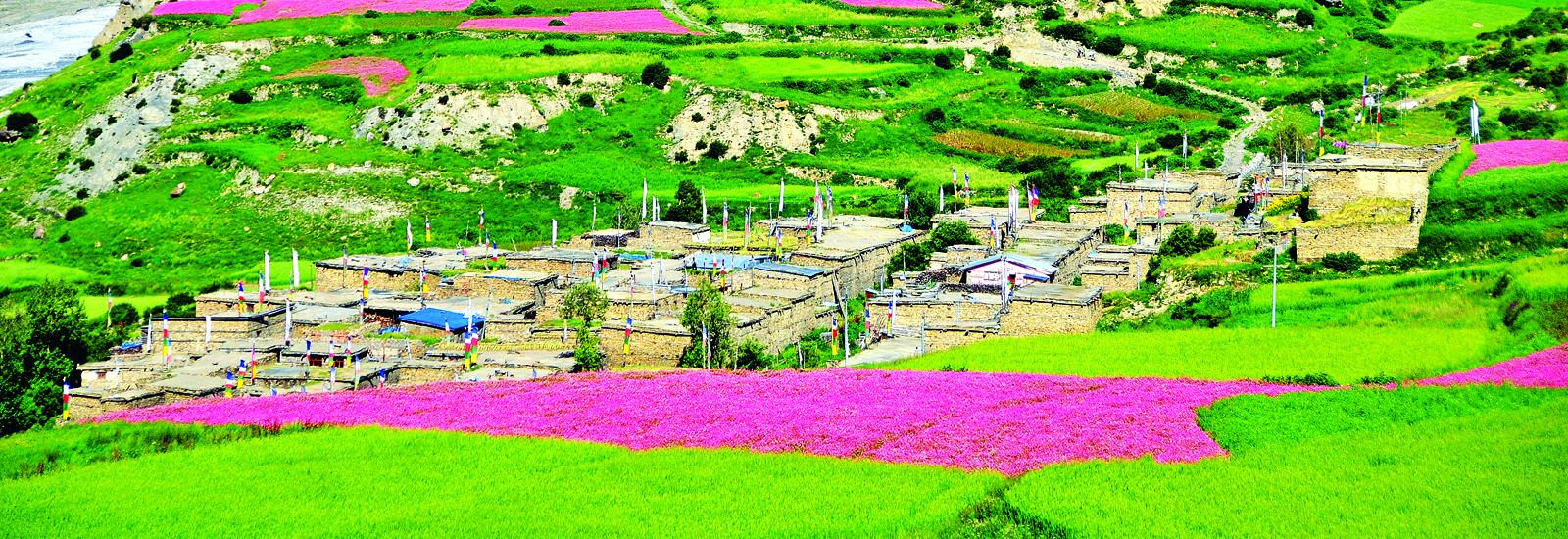Overview:
The Annapurna Circuit Trek is renowned as one of the most spectacular trekking experiences in the world. This 15-day Annapurna Circuit Trek adventure takes you on a journey around the majestic Annapurna mountain range in Nepal, offering a diverse range of landscapes and an immersive cultural experience. Also known as the Round Annapurna Trek, this route spans approximately nine days and covers a variety of terrains, from lush valleys to high-altitude passes. The Circuit trek to Annapurna begins in the lush subtropical forests of the lower river valleys. As you move forward, you gradually ascend through terraced fields and traditional villages. The trail offers panoramic views of the Annapurna and Dhaulagiri ranges, with their snow-capped peaks standing majestically against the sky. One of the most significant Annapurna Circuit highlights is crossing the Thorong La Pass, which sits at an altitude of 5,416 meters (17,769 feet). The Annapurna Circuit trek distance spans approximately 160 - 230 kilometers, offering a challenging yet rewarding journey for avid trekkers.
This high mountain pass is one of the highest trekking passes in the world, and reaching it is a notable achievement for trekkers. The Annapurna Circuit Trek is known for its diverse environment. The trek takes you through different climatic zones, allowing you to experience the transformation of the environment from subtropical to alpine to desert-like conditions. The trek to annapurna circuit is challenging and requires good physical fitness due to the high altitude and the demanding nature of the terrain. The ascent to Thorong La Pass is particularly strenuous, and trekkers may experience altitude sickness if not properly acclimatized. The lower Annapurna Circuit elevation feature lush greenery and warm temperatures, while higher altitudes reveal arid, high-altitude landscapes with dramatic views of the surrounding peaks. However, the breathtaking scenery and the sense of accomplishment upon completing the trek make it a highly rewarding experience.
In addition to the natural beauty, the Annapurna Circuit trek offers a unique opportunity to experience the local culture. You’ll pass through traditional villages inhabited by the Gurung, Magar, and Tibetan communities. These villages provide insights into local customs, traditions, and lifestyles. Visiting monasteries and interacting with the friendly locals adds a cultural dimension to the Annapurna Circuit adventure. Trekking the annapurna circuit is celebrated for its combination of stunning natural beauty, diverse landscapes, and rich cultural experiences. The Annapurna Circuit is a journey that challenges and rewards trekkers, making it one of the most popular and revered trekking routes in the Himalayas. If you are prepared for the physical demands and eager for an unforgettable adventure, this trek is a true Himalayan classic.
An Excellent Blend of Culture and Adventure
While Trekking Annapurna Circuit, you will experience the incredible culture and adventure of the region. As you walk past several beautiful villages along the trail, you can enjoy the lifestyle and culture of the people living there. From the lower river valley lifestyle to the high mountain cultures, you will experience diverse cultural riches.
The trek also takes you to the highest elevation of Annapurna Circuit region. A high mountain pass – Thorong La – that stands at the elevation of 5416 meters above sea level is a challenging pass to cross. But the most adventurous Annapurna Circuit highlights is the early morning walk towards the pass to cross it. The walk that starts in the Marshyangdi River valley ends in the Kali Gandaki River valley. And the Annapurna trekking circuit experience in between is simply unearthly. You will also visit and explore the famous pilgrimage of Muktinath. Our Jomsom Trek takes you there from a different route.
For you to make this trip easier, our comprehensive Annapurna Circuit Trek map guides you through every scenic trail and hidden gem of this iconic trek. Fresh mountain air, beautiful natural surroundings, and views of the mountains also add to the beauty of this trek. You can enjoy the view of massive mountains like Annapurna, Dhaulagiri, Manaslu, Tukuche, Fishtail, etc.
You can also check our Annapurna Sanctuary Trek if you are looking for multiple options to choose from.
Reasons this trip becomes an Experience
Nepal Climbing Adventure always strives to offer an adventure traveling experience that you can cherish. While trekking the annapurna circuit is beautiful in its all essence, your experience of trekking there becomes even more beautiful with us.
By the time we take you to the base camp and bring you back, we take one step ahead to offer you a beautiful experience. We keep your safety and happiness as our top priority and you will experience the same during the trip. Experience the ultimate adventure with our Annapurna Circuit Trek package, offering breathtaking views and unforgettable moments.
This 15-day Trekking trip around the Annapurna with us is traveling in safe hands.
Highlights for the Annapurna Circuit:
- Experience a stunning range of environments, from lush subtropical forests and terraced fields to arid high-altitude deserts.
- Explore traditional villages of different ethnic communities, including Gurung, Thakali, and Manangi, with their unique customs and architecture.
- Marvel at panoramic views of the Annapurna and Dhaulagiri mountain ranges, including iconic peaks like Annapurna II, Annapurna IV, and Machapuchare.
- Conquer the high-altitude Thorong La Pass (5,416 meters), the highest point on the trek, and be rewarded with breathtaking views.
- Relax in natural hot springs at Tatopani, soothing your muscles after long trekking days.
- Visit ancient monasteries and temples, including the Manang Gompa and the Muktinath Temple, significant for both Buddhists and Hindus.
- Encounter a rich variety of plant and animal life, from dense rhododendron forests to unique high-altitude species.
- Enjoy the warm hospitality of local teahouses and guesthouses, experiencing Nepalese cuisine and culture up close.
- Face the physical challenge of high-altitude trekking, with varied terrain and Annapurna Circuit weather conditions adding to the adventure.
- Witness awe-inspiring sunrises over the Himalayas, especially from viewpoints like Poon Hill.
Trek Route:
The circuit trek to annapurna region offers a spectacular journey through a diverse array of landscapes and cultures. Beginning in Kathmandu, the trek follows a route that gradually ascends from the lush, subtropical valleys of the lowlands to the high-altitude deserts of the Tibetan plateau. Travelers traverse through charming villages like Chamje and Dharapani, each with its unique character and culture, and pass through the bustling town of Chame, where the scenery starts to change to alpine forests and rocky trails.
The trek continues to Pisang and Manang, where trekkers gain altitude and acclimatize to the thinning air, with stunning views of the Annapurna and Gangapurna ranges. The challenging ascent to Thorong La Pass, one of the highest trekking passes in the world at 5,416 meters, is a highlight of the trek, offering breathtaking vistas of the surrounding peaks. The descent leads to the sacred site of Muktinath, and eventually, to the wind-swept valley of Jomsom. The journey concludes with a return to Pokhara, a serene lakeside city, before heading back to Kathmandu, reflecting on an epic Annapurna Circuit adventure through the heart of the Himalayas.
Difficulty Level for Annapurna Circuit Trek
The trek to annapurna circuit is a popular trekking route in Nepal, known for its stunning scenery and diverse landscapes. The Annapurna Circuit trek difficulty level of this trek varies depending on several factors, including your fitness level, experience, and the time of year you choose to trek. The trek to annapurna circuit is considered a moderate to challenging trek. The trek covers about 160 to 230 kilometers (100 to 145 miles), depending on the exact route you take. It usually takes around 15 to 20 days to complete, which includes acclimatization days to help you adjust to the annapurna circuit trek altitude. One of the main challenges of the Annapurna Circuit is the high altitude. The trek reaches an elevation of 5,416 meters (17,769 feet) at Thorong La Pass, which is the highest point on the circuit.
This means you will be Trekking Annapurna Circuit at high altitudes where the air is thinner and oxygen levels are lower. Trekking at such heights can lead to altitude sickness, so it’s important to acclimatize properly and listen to your body. Another difficulty is the changing Annapurna Circuit weather. The weather in the Himalayas can be unpredictable, with temperatures ranging from freezing cold at higher altitudes to warm and sunny lower down. Snow, rain, and strong winds can occur, especially during the monsoon season (June to September) and winter months (December to February). The trek also involves a variety of terrain, including steep ascents and descents, rocky paths, and river crossings.
Some sections can be quite strenuous, particularly around the Thorong La Pass. Proper trekking gear, including sturdy hiking boots, warm clothing, and rain protection, is essential. Physical fitness plays a crucial role in your ability to complete the circuit trek to annapurna region. Regular exercise and training before your trek can help you build the stamina and strength needed for the journey. It’s also beneficial to have previous trekking experience, although beginners can still complete the trek with proper preparation and support. The trek to annapurna circuit offers a rewarding experience with breathtaking views and cultural encounters, but it requires good physical fitness, careful planning, and readiness for various challenges.
What makes the Annapurna Circuit Trek special?
The Annapurna Circuit adventure is remarkable and stands out for several reasons. One of its most notable features is its incredible diversity. The trek takes you through various landscapes, from lush subtropical forests to high-altitude deserts. You’ll experience different climates and ecosystems as you move from lowland villages to alpine meadows and stark, high-altitude deserts. Another Annapurna Circuit highlights is the opportunity to immerse yourself in the rich culture of the region. The trek passes through numerous traditional villages where you can interact with local people and learn about their customs and way of life. The circuit also offers breathtaking views of the Annapurna and Dhaulagiri mountain ranges, with stunning vistas at every turn.
The trek is also famous for its unique geographical features. You’ll cross the Thorong La Pass, which is one of the highest trekking passes in the world at an elevation of 5,416 meters (17,769 feet). This challenging pass provides panoramic views of the surrounding peaks and is a significant achievement for trekkers. The Annapurna Circuit is known for its well-established teahouse system. This means you can enjoy comfortable lodgings and delicious meals prepared by local hosts. The availability of teahouses makes the trek more accessible and enjoyable, as you don't need to carry heavy camping gear. The Annapurna trekking circuit is special because it combines diverse landscapes, rich cultural experiences, and stunning natural beauty, making it one of the most popular and rewarding treks in the Himalayas.
15 Days Annapurna Circuit Trek Cost for 2024 and 2025
The Annapurna Circuit trek cost can vary significantly based on factors like trek duration, level of comfort, and the services included. Here’s a cost detail for the 15-day Annapurna Circuit Trek for 2024 and 2025:
Permits and Fees:
- TIMS Card (Trekkers' Information Management System): $10 - $20
- ACAP (Annapurna Conservation Area Permit): $30 - $50
- Local Government Fees: $10 - $20
Guides and Porters:
- Guide (Optional): $25 - $40 per day
- Porter (Optional): $20 - $30 per day
Accommodation:
- Teahouse Lodging (per night): $5 - $10 per person
- Total for 14 nights: $70 - $140
Meals:
- Breakfast, Lunch, Dinner (per day): $15 - $30
- Total for 15 days: $225 - $450
Transportation:
- Kathmandu to BesiSahar (bus): $15 - $30
- Besi Sahar to Chamje (jeep): $10 - $20
- Return to Kathmandu (bus): $15 - $30
Miscellaneous:
- Water and Snacks: $5 - $10 per day
- Total for 15 days: $75 - $150
- Travel Insurance: $50 - $100
Luxury Options:
- Private Transport (Comfortable Vehicle): $150 - $300
- Luxury Lodging (per night): $20 - $50 per person
- Total for 14 nights: $280 - $700
- Upgraded Meals and Services: $200 - $400
Best Time to Hike Annapurna Circuit
The Annapurna trekking circuit is a popular and diverse trek in Nepal, known for its stunning scenery and varied landscapes. Choosing the Annapurna Circuit trek best time to undertake this trek is crucial for ensuring a pleasant experience. Here's a detailed look at the ideal times for trekking the Annapurna Circuit:
Autumn (September to November) is the Best time to hike Annapurna Circuit. During this season, the weather is stable with mostly clear skies. Temperatures range from 10°C to 20°C (50°F to 68°F) at lower altitudes and are colder at higher elevations. The scenery is stunning, with lush green landscapes from the monsoon rains and blooming rhododendron forests. The clear skies offer breathtaking views of the Himalayas. This period is also the peak trekking season, so the trails can be busy with many trekkers. Despite the crowds, the vibrant atmosphere and the range of available services make autumn a popular choice for this trek.
Spring (March to May) is another great time for the Circuit trek to Annapurna region. The weather is generally stable, with temperatures ranging from 15°C to 25°C (59°F to 77°F) in the lower regions and cooler at higher elevations. It’s warmer compared to autumn and has a lower chance of snowfall. The scenery is beautiful, with blooming flowers, especially rhododendrons, and clear views of the mountains. Although the trail is less crowded than in autumn, it is still a popular trekking season. This means you can enjoy a more peaceful experience while still having access to many services and amenities.
Summer (June to August) is the monsoon season in Nepal, bringing heavy rainfall to the Annapurna region. The Annapurna Circuit weather can be challenging, with temperatures ranging from 20°C to 30°C (68°F to 86°F) at lower elevations and variable conditions at higher altitudes. The constant rain makes the trails muddy and slippery, and landslides are a risk. While the landscapes become lush and green, the heavy rains can obscure views of the mountains. Summer is the off-season for trekking, so there are fewer trekkers on the trail. However, the wet and muddy conditions can make the trek less enjoyable and more difficult.
Winter (December to February) brings very cold temperatures to the circuit trek to annapurna region. At higher elevations, temperatures often drop below freezing, and heavy snowfall can make conditions harsh. The lower regions are milder, but the weather can still be challenging. The snow-covered landscape offers a unique and serene beauty, with stunning winter views of the Annapurna range. However, the cold and potential for heavy snow can make trekking difficult and less enjoyable. Winter is the least popular season for trekking due to these harsh conditions, resulting in fewer trekkers on the trail. If you enjoy solitude and don't mind the cold, winter can offer a peaceful trekking experience.
Annapurna Circuit Trek Permit
For this trek, you’ll need several Annapurna Circuit permits:
Annapurna Conservation Area Permit (ACAP):
- Required for entry into the Annapurna Conservation Area.
- Cost: Approximately $30 USD.
- Obtainable at the Nepal Tourism Board or in Kathmandu/Pokhara.
- Trekkers' Information Management System (TIMS) Card:
- Ensures safety and track trekkers in the region.
- Cost: Around $10 USD.
- Available at the Nepal Tourism Board in Kathmandu or Pokhara.
FAQ's
Frequently Asked Questions (FAQ’s)
1. How long does it take to trek the Annapurna Circuit?
The Annapurna trekking circuit typically takes around 15 to 20 days to complete, depending on the chosen itinerary and trekking pace. This duration allows for proper acclimatization and exploration of the diverse landscapes and cultural sites along the route.
2. How difficult is Annapurna Circuit Trek?
Trekking the annapurna circuit is considered moderately challenging, requiring good physical fitness and stamina. The trek involves varying terrain, altitude gains, and the crossing of the Thorong La Pass at 5,416 meters, making proper acclimatization and preparation essential.
3. Can the Annapurna Circuit be done in 10 days?
Completing the Annapurna Circuit in 10 days is quite ambitious and may require a faster pace, limiting time for acclimatization and exploration. While it is possible, it is generally recommended to allow 15 to 20 days to fully enjoy the trek and reduce the risk of altitude sickness.
4. Is Annapurna Circuit still worth it?
Yes, the Annapurna Circuit is still highly regarded for its breathtaking views, diverse landscapes, and rich cultural experiences. Despite changes in infrastructure and increased traffic, it remains a classic trek offering an immersive adventure in the heart of the Himalayas.
5. Do I need a permit for the Annapurna Circuit Trek?
Yes, All of the necessary Annapurna Circuit permits for your trek are included in the price and will be arranged for you prior to your trek.. You need the Annapurna Conservation Area Permit (ACAP) and the Trekker's Information Management System (TIMS) card, which can be obtained through registered trekking agencies or at the Nepal Tourism Board offices.
6. What is the highest point on the Annapurna Circuit?
The highest point on the Annapurna Circuit is the Thorong La Pass, which stands at 5,416 meters (17,769 feet) above sea level. Crossing this pass is a significant highlight of the trek, offering spectacular panoramic views of the surrounding peaks.
7. Is it possible to do the Annapurna Circuit Trek in the winter?
Yes, it is possible to trek to annapurna circuit in winter, but it comes with added challenges. Winter weather can bring heavy snowfall and cold temperatures, particularly at higher elevations, which can make the trek more difficult and increase the risk of altitude sickness.
8. Is Annapurna harder than Everest?
The Annapurna Circuit is generally considered more challenging in terms of altitude and terrain compared to the Everest Base Camp Trek. The Annapurna Circuit involves higher elevation passes and more varied terrain, while the Everest Base Camp Trek is less demanding in terms of altitude but still requires good physical fitness and acclimatization.
9. Can beginners do the Annapurna Circuit?
Beginners can attempt the Annapurna Circuit, but it's crucial to have a reasonable level of fitness and prepare adequately. Proper acclimatization and a well-planned itinerary are essential to handle the trek's physical demands and high altitude effectively.
10. When is the best time for the Annapurna Circuit trek?
The best time for trekking the annapurna circuit is during the spring (March to May) and autumn (September to November) seasons. These periods offer stable weather, clear skies, and favorable trekking conditions, making them ideal for experiencing the trek's diverse landscapes and views.
11. Is altitude sickness a concern on this trek?
Yes, altitude sickness is a concern on the Annapurna trekking circuit, especially when crossing the Thorong La Pass at 5,416 meters. Proper acclimatization, gradual ascent, and staying hydrated are crucial to minimize the risk and ensure a safe trekking experience.
12. Can I trek the Annapurna Circuit independently, or do I need a guide?
You can trek the Annapurna Circuit independently, but having a guide or porter can enhance safety and provide valuable local knowledge. Although independent trekking is allowed, hiring a guide or joining a group can offer additional support and make the experience more enjoyable.
13. What is overnight accommodation like?
Overnight Annapurna Circuit accommodation typically involves staying in tea houses or lodges, which offer basic amenities such as a bed, communal dining area, and shared bathrooms. Accommodations vary in comfort, with some offering more facilities and a warmer environment, especially at higher altitudes.
14. Can we change the itinerary?
Yes, you can modify the Annapurna Circuit itinerary to suit your preferences or needs. It's advisable to discuss any changes with your trekking agency or guide to ensure adjustments align with safety and logistical considerations.





















